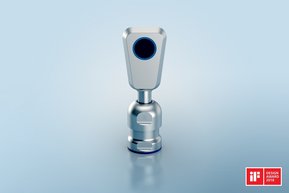SKINTOP® HYGIENIC convinces thanks to high retention force
Installing sensors? Here’s how we helped microsonic with their hygienic design

In the Food and Beverage industry, containers or receptacles need to be counted and positioned with precision. Because hygiene requirements for machinery and technical components are getting increasingly stricter, standard sensors are no longer fully fit for use in areas that come into contact with foodstuff. This gap in the market is now filled by the pms ultrasonic sensors from microsonic, designed in compliance with the European Hygienic Engineering and Design Group (EHEDG) guidelines and constructed from FDA-tested materials.
The installation of hygienically sound sensors on packaging or processing machinery forms a fundamental component of the guidelines published by the EHEDG. When searching for hygienically sound and simple sensor installation, microsonic found what they needed at LAPP. Melanie Harke, Head of Marketing at microsonic, recalls that a few cable glands were tested, yet it was only the SKINTOP® HYGIENIC from LAPP that satisfied all requirements. Resistance to twisting is a problem when combining sensors and cable glands; the sensor needs to be firmly fixed in place after its assembly and it must not twist in its mounting – i.e. the gable gland – while maintenance or automatic cleaning procedures are in progress.
The secret of the SKINTOP® cable gland’s ability to prevent twisting so effectively is in its special construction; the geometry of the individual parts and the selection of materials for the latter. Although conventional cable glands also contain an elastomer seal, at LAPP we pay attention during the development phase to fix and seal all materials installed for cables, conduits and pipes as effectively as possible. When choosing an elastomer, it is necessary to possess a certain expertise with regard to suitable designs, shore hardness levels, material displacement and the consequently attainable retention force. These are all things that can have a positive impact on the protection against twisting. If the elastomer encircles the cable, such as when it is positioned around the 12-mm-thick sensor shaft of the microsonic unit, it prevents the sensor from being pulled out or twisted.
The elastomer seal for the cable on the SKINTOP® HYGIENIC is longer: when the nut is tightened, a certain volume is additionally displaced along the inside of the domed cap nut. This results in a higher retention force, prevents twisting and reliably fills potential dead spaces between the elastomer sealing ring and stainless-steel tube or cable.
Our engineers came up with an ingenious design to ensure that this worked. SKINTOP® typically conceals a plastic basket with flexible ribs beneath the domed cap nut. Internally, the domed cap nut is tapered to the optimum degree of efficiency and presses these ribs downwards and inwards when screwed down, where they press against the sealing ring. Doing so guarantees controlled material displacement, high retention forces, and prevents the cable and/or sensor from being pulled out. The stainless-steel base features small indentations, into which the corresponding pins of the ribbed basket engage to ensure that the smooth plastic of the basket doesn’t become twisted in the stainless-steel housing. As a result, neither the basket nor the cable or sensor twist - they all remain stable.


